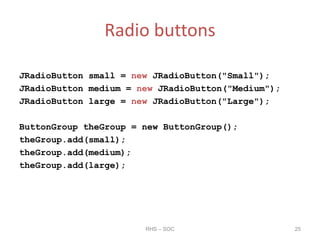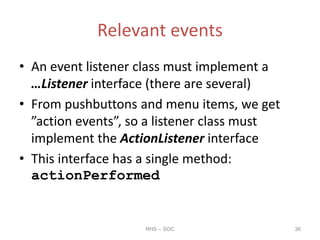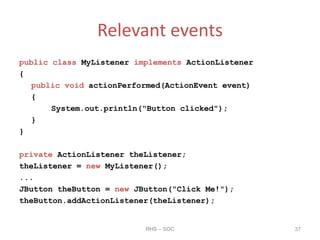GUI Programming using NetBeans.pptx
- 2. GUI construction • Elements in a (simple) GUI – Frames, Panes and Dialogs – Text fields – Lists and Combo boxes – Check and Radio buttons • How to use GUI controls in an application? RHS – SOC 2
- 3. GUI construction • In general, we have two options when constructing a GUI – Build it ”by hand” using Swing API – Use the NetBeans GUI Builder • Using the GUI Builder is usually much easier than hand-coding the GUI • Does not give you complete control, however… RHS – SOC 3
- 4. GUI construction RHS – SOC 4
- 5. GUI construction • If you wish to construct a GUI manually, you usually begin by creating a JFrame • A JFrame object is essentially an empty window, into which you can add containers for GUI controls • Typically, you will add a JPanel to the frame – the JPanel object will contain the actual GUI controls RHS – SOC 5
- 6. GUI construction public static void main(String[] args) { JFrame theFrame = new JFrame(); theFrame.setBounds(200, 200, 720, 450); theFrame.setVisible(true); JPanel thePanel = new JPanel(); theFrame.add(thePanel); } RHS – SOC 6
- 7. GUI construction • On the JPanel object, various layout strategies can be used – Flow layout – left to right – Border layout – groups into areas – Grid layout – groups into a grid • Border layout is default, and also most commonly used RHS – SOC 7
- 8. GUI construction • Using border layout, the panel is divided into five areas – Center – North – South – East – West RHS – SOC 8
- 9. GUI construction • If a control is put into an area, it will expand to fill out the area • Good when resizing, but may look weird… • If you need a finer level of control, put a panel inside a panel… • …or maybe consider a different layout RHS – SOC 9
- 10. GUI construction public static void main(String[] args) { JFrame theFrame = new JFrame(); theFrame.setBounds(200, 200, 240, 150); theFrame.setVisible(true); JPanel thePanel = new JPanel(); thePanel.setLayout(new BorderLayout()); thePanel.add(new Button("Center"), BorderLayout.CENTER); theFrame.add(thePanel); } RHS – SOC 10
- 11. Exercises • Try out create an application which looks like the picture to the right, without using the GUI Builder. • That is, create it only by using the Swing API methods as shown in the presentation. • Remember that you can put panels within panels… RHS – SOC 11
- 12. Text field • Two common purposes: – Allow the user to enter data as text – Display text data to the user • A text field can be ”enabled” or ”disabled” – Enabled: Data can be entered – Disabled: Data can only be displayed • At some point we need to set or extract the text from the text field RHS – SOC 12
- 13. Text field JFrame theFrame = new JFrame(); theFrame.setBounds(200, 200, 300, 300); JPanel thePanel = new JPanel(); thePanel.setLayout(new BorderLayout()); JTextField theTextField = new JTextField(); thePanel.add(theTextField, BorderLayout.NORTH); theFrame.add(thePanel); theFrame.setVisible(true); RHS – SOC 13
- 14. Text field RHS – SOC 14 Text field
- 15. Text field • Enabling a text field theTextField.setEditable(true); • Disabling a text field theTextField.setEditable(false); • Setting the text in a text field theTextField.setText("Greeting earthlings!"); • Getting the text from a text field String s = theTextField.getText(); RHS – SOC 15
- 16. List box / Combo box • A list (or combo) box enables the user to choose an option between many alternatives • List box: User can only choose between specified alternatives • Combo box: User can choose between specified alternatives, or specify choice manually (type it in) RHS – SOC 16
- 17. List box / Combo box Object[] choices = {"One", "Two", "Three", "Four"}; JComboBox theBox = new JComboBox(choices); theBox.setEditable(true); thePanel.add(theBox, BorderLayout.NORTH); RHS – SOC 17
- 18. List box / Combo box RHS – SOC 18 Combo box (editable)
- 19. List box / Combo box • Enabling a Combo box theBox.setEditable(true); • Disabling a Combo box theBox.setEditable(false); • Setting the selection in a Combo box theBox.setSelectedItem(”Three"); • Getting the selection from a Combo box String s = (String)theBox.getSelectedItem(); RHS – SOC 19
- 20. Check boxes • In some cases, the set of possible choices is limited to two options • Often a case of either/or, or perhaps on/off • A Check box can only be in two states; checked or unchecked • Nice fit for binary choices RHS – SOC 20
- 21. Check boxes JCheckBox theBBox = new JCheckBox("Bold"); JCheckBox theIBox = new JCheckBox("Italic"); JCheckBox theUBox = new JCheckBox("Underline"); thePanel.add(theBBox,BorderLayout.WEST); thePanel.add(theIBox,BorderLayout.NORTH); thePanel.add(theUBox,BorderLayout.EAST); RHS – SOC 21
- 22. Check boxes RHS – SOC 22
- 23. Check boxes • Enabling a Check box theCBox.setEnabled(true); • Disabling a Check box theCBox.setEnabled(false); • Setting the selection in a Check box theCBox.setSelected(isSelected); • Getting the selection from a Check box boolean isSelected = theCBox.isSelected(); RHS – SOC 23
- 24. Radio buttons • If the number of choices is few, and they are mutually exclusive, use a group of Radio buttons • Only one button in a group of Radio buttons can be selected RHS – SOC 24
- 25. Radio buttons JRadioButton small = new JRadioButton("Small"); JRadioButton medium = new JRadioButton("Medium"); JRadioButton large = new JRadioButton("Large"); ButtonGroup theGroup = new ButtonGroup(); theGroup.add(small); theGroup.add(medium); theGroup.add(large); RHS – SOC 25
- 26. Radio buttons RHS – SOC 26
- 27. Radio buttons • Enabling a Radio button theRB.setEnabled(true); • Disabling a Radio button theRB.setEnabled(false); • Setting the selection in a Radio button theRB.setSelected(isSelected); • Getting the selection from a Radio button boolean isSelected = theRB.isSelected(); RHS – SOC 27
- 28. Radio buttons • Note that even though only one Radio button in a group can be selected, we must call isSelected() until we find it… • Putting Radio buttons in a group does not make them appear grouped visually RHS – SOC 28
- 29. Exercises • Try out create an applica-tion which looks like the picture to the right, without using the GUI Builder. • Only one radio button should be selected at all times • Font for a control can be set using the setFont method (see the docu-mentation) RHS – SOC 29
- 30. The concept of events • On the inside (code), GUI code has a very different structure than ”usual” code • Usual code is driven by con- ditions and various control structures (if, while,…) • GUI code is driven by events RHS – SOC 30
- 31. The concept of events • Execution of GUI code is much more unpredictable than for usual code • We cannot predict – or dictate – what the user does, so we must always handle any possible action the user can do • A user action related to the GUI is called an event RHS – SOC 31
- 32. The concept of events RHS – SOC 32
- 33. The concept of events • Almost all actions the user performs will ”trigger” an event for us to handle – Moving the mouse – Clicking on a button – Writing text in a text box – ….and so on • There are hundreds of possible events! RHS – SOC 33
- 34. The concept of events • Fortunately, is it optional to respond to an event • We only need to do so, if we want any special action to happen • If that is the case, we must write an event handler for that particular event RHS – SOC 34
- 35. Relevant events • Unless we need more sophisticated behavior, we only need to handle two types of events – Choosing a menu item – Clicking on a push button • In both cases, we must create an object which can listen for events from the control in question RHS – SOC 35
- 36. Relevant events • An event listener class must implement a …Listener interface (there are several) • From pushbuttons and menu items, we get ”action events”, so a listener class must implement the ActionListener interface • This interface has a single method: actionPerformed RHS – SOC 36
- 37. Relevant events public class MyListener implements ActionListener { public void actionPerformed(ActionEvent event) { System.out.println("Button clicked"); } } private ActionListener theListener; theListener = new MyListener(); ... JButton theButton = new JButton("Click Me!"); theButton.addActionListener(theListener); RHS – SOC 37
- 38. Relevant events • A very common dialog construction: – Add an ”OK” button – In the event listener for the button • Retrieve data from the relevant controls • Process the data • Close the dialog • Pressing ”OK” means: ”Now my input is ready, do something with it!” RHS – SOC 38
- 39. Wrapping up • GUI programming is somewhat difficult and tedious • Unless you need something special, use the NetBeans GUI Builder! • Always nice to know what does on under the hood… • You can – to some degree – mix manual coding and using the GUI Builder RHS – SOC 39
- 40. Exercises • Try out create an application which looks like the picture to the right, without using the GUI Builder. • Create event listeners for the buttons, that print the texts: – ”Brrr” for Arctic and Antarctic – ”Puhh” for America and Asia – ”Wet!” for Atlantic • You should not write more than three event listeners! RHS – SOC 40






![GUI construction
public static void main(String[] args)
{
JFrame theFrame = new JFrame();
theFrame.setBounds(200, 200, 720, 450);
theFrame.setVisible(true);
JPanel thePanel = new JPanel();
theFrame.add(thePanel);
}
RHS – SOC 6](https://image.slidesharecdn.com/gui-20programming-20using-20netbeans-150117003355-conversion-gate02/85/GUI-Programming-using-NetBeans-pptx-6-320.jpg)



![GUI construction
public static void main(String[] args)
{
JFrame theFrame = new JFrame();
theFrame.setBounds(200, 200, 240, 150);
theFrame.setVisible(true);
JPanel thePanel = new JPanel();
thePanel.setLayout(new BorderLayout());
thePanel.add(new Button("Center"), BorderLayout.CENTER);
theFrame.add(thePanel);
}
RHS – SOC 10](https://image.slidesharecdn.com/gui-20programming-20using-20netbeans-150117003355-conversion-gate02/85/GUI-Programming-using-NetBeans-pptx-10-320.jpg)






![List box / Combo box
Object[] choices =
{"One", "Two", "Three", "Four"};
JComboBox theBox = new JComboBox(choices);
theBox.setEditable(true);
thePanel.add(theBox, BorderLayout.NORTH);
RHS – SOC 17](https://image.slidesharecdn.com/gui-20programming-20using-20netbeans-150117003355-conversion-gate02/85/GUI-Programming-using-NetBeans-pptx-17-320.jpg)






















